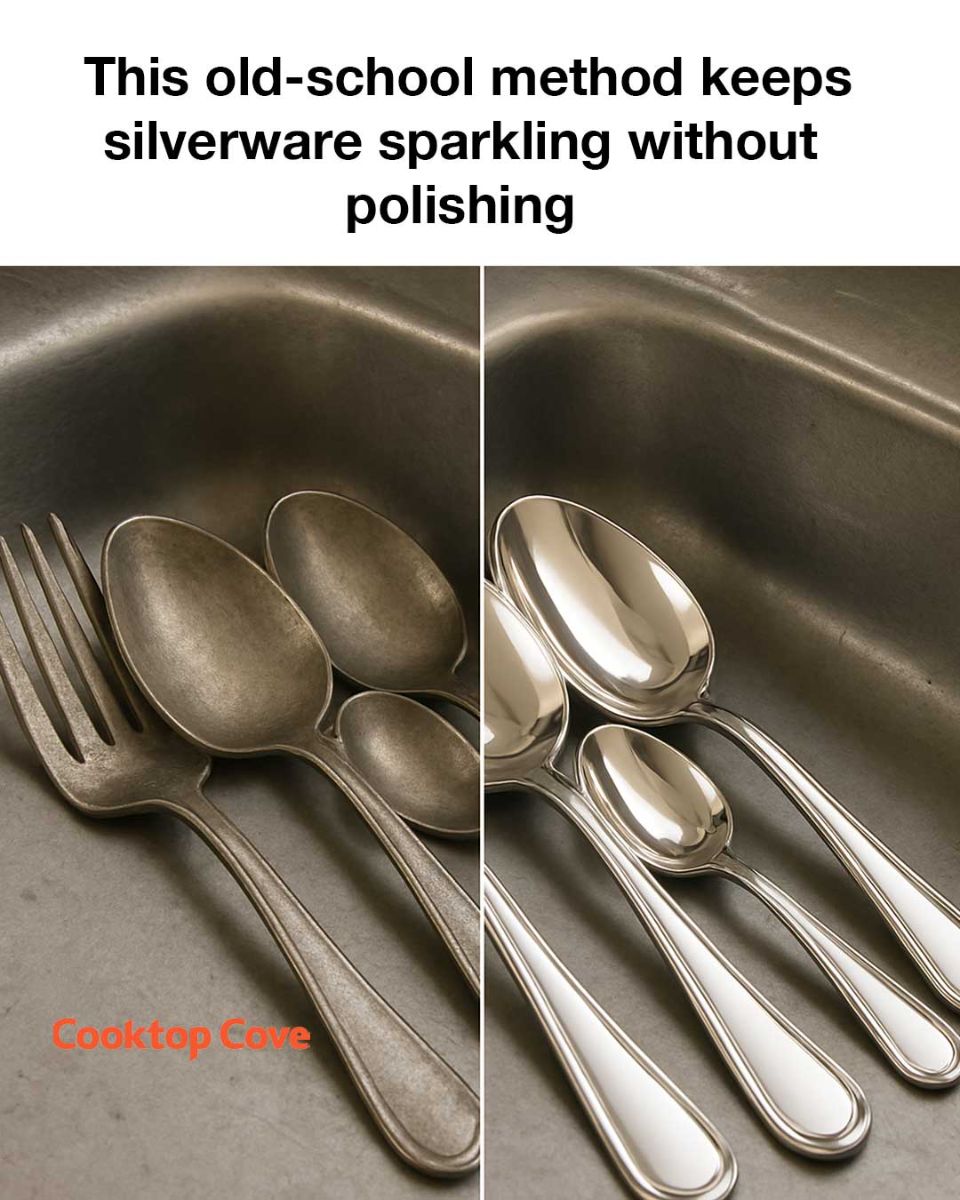Love this method
McKayla Davis
Contributing Writer
Print this recipe
In a world where convenience often trumps tradition, the art of maintaining silverware has largely been relegated to the realm of professional cleaners and modern chemical polishes. However, there’s a time-tested method that keeps silverware sparkling without the need for constant polishing, and it involves nothing more than a few household items. This old-school technique not only revives the natural luster of silver but also offers a sustainable and cost-effective alternative to commercial products.
For generations, families have passed down this simple yet effective method, which relies on the chemical reaction between baking soda, aluminum foil, and hot water to remove tarnish. This approach is not only rooted in tradition but also supported by science, making it a reliable choice for those looking to maintain their silverware’s shine without resorting to harsh chemicals or expensive treatments.
1. The Surprising History of Silverware Maintenance
Silverware has been a symbol of wealth and refinement for centuries, dating back to the aristocratic households of Europe. The maintenance of silverware was a task often entrusted to skilled servants who used a variety of methods to keep the pieces gleaming. In the 18th and 19th centuries, silver was polished using a paste made from whiting (a fine chalk) and ammonia, which was effective but labor-intensive.
As the Industrial Revolution brought about new cleaning products, the traditional methods began to fade. However, the simplicity and effectiveness of using natural elements like baking soda and aluminum foil have endured, preserving this method as a cherished household secret. The resurgence of interest in sustainable and eco-friendly practices has brought this old-school method back into the spotlight, reminding us of its historical significance and practicality.
2. Why Traditional Methods Still Matter
In an age where synthetic cleaners are readily available, traditional methods hold a special place due to their simplicity and effectiveness. Unlike modern polishes that often contain harsh chemicals, the baking soda and aluminum foil method is gentle on silver and the environment. This method doesn’t just clean the surface; it reverses the chemical reaction that causes tarnish, restoring the silver’s original shine.
Moreover, traditional methods are accessible to everyone. With just a few household items, anyone can achieve professional-level results without the need for specialized products. This democratization of silver maintenance is particularly appealing in today’s DIY culture, where people are increasingly interested in taking control of their home care routines.
3. The Science Behind Tarnish and Shine
Silver tarnish is a result of a chemical reaction between silver and sulfur-containing substances in the air, such as hydrogen sulfide. This reaction forms silver sulfide, which appears as a dark coating on the surface of silver items. The baking soda and aluminum foil method works by reversing this reaction through a process known as ion exchange.
When silverware is submerged in a hot water bath with baking soda and aluminum foil, the aluminum acts as a sacrificial anode. The sulfur atoms are attracted to the aluminum, breaking the bond with the silver and transferring to the foil. This process effectively removes the tarnish without removing any silver, unlike abrasive polishes that can wear down the metal over time.
4. The Old-School Method: Baking Soda and Aluminum Foil
The baking soda and aluminum foil method is a simple yet ingenious way to clean silverware. It requires only a few common household items: baking soda, aluminum foil, hot water, and a non-metal container. This method is not only effective but also safe for the environment, as it doesn’t involve any toxic chemicals.
The process involves lining a container with aluminum foil, placing the tarnished silverware inside, and sprinkling it with baking soda. Hot water is then poured over the silverware, initiating the chemical reaction that removes tarnish. This method is particularly effective for intricate pieces with hard-to-reach areas, as the solution can penetrate and clean every nook and cranny.
5. Step-by-Step Guide to the Aluminum Foil Trick
To begin, line the bottom of a non-metal container with aluminum foil, shiny side up. Place the tarnished silverware on top of the foil, ensuring that each piece is in contact with the foil. Sprinkle a generous amount of baking soda over the silverware, approximately 1 tablespoon per cup of water.
Next, carefully pour boiling water over the silverware until it is fully submerged. You should see bubbles forming as the reaction begins. Allow the silverware to soak for 5 to 10 minutes, depending on the level of tarnish. Once the tarnish has lifted, remove the silverware, rinse it under warm water, and dry it with a soft cloth. The result is sparkling silverware without the need for polishing.
6. How This Method Compares to Modern Polishes
Modern silver polishes often contain abrasive compounds that physically remove tarnish along with a thin layer of silver. While effective, this can lead to thinning of the silver over time, especially with frequent use. In contrast, the baking soda and aluminum foil method is non-abrasive and preserves the integrity of the silver.
Furthermore, commercial polishes can be expensive and contain chemicals that may be harmful to the environment. The traditional method uses inexpensive, non-toxic ingredients that are readily available in most households. This makes it not only a safer choice for the environment but also a more economical option for maintaining silverware.
7. Environmental Benefits of Using Household Items
The environmental impact of cleaning products is a growing concern, with many commercial polishes containing chemicals that can be harmful to aquatic life and contribute to pollution. The baking soda and aluminum foil method uses natural ingredients that are biodegradable and safe for the environment.
By opting for this traditional method, you reduce your reliance on chemical-laden products and minimize your carbon footprint. This approach aligns with the principles of sustainable living, promoting the use of renewable resources and reducing waste. It’s a small but meaningful step towards a more eco-friendly lifestyle.
8. Cost-Effectiveness of the Traditional Approach
One of the most appealing aspects of the baking soda and aluminum foil method is its cost-effectiveness. Baking soda and aluminum foil are inexpensive and commonly found in most households, making this method accessible to everyone. In contrast, commercial silver polishes can be costly, especially when used frequently.

